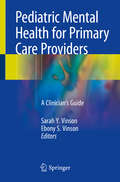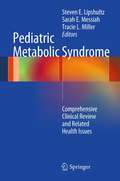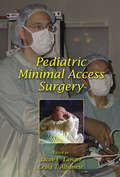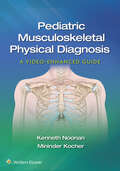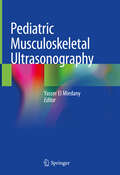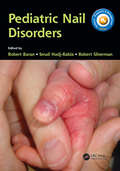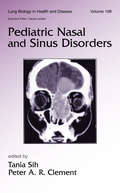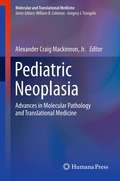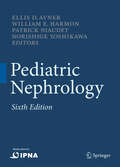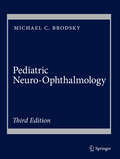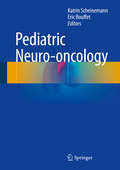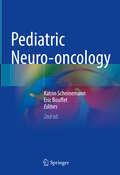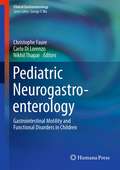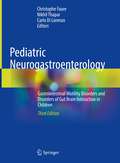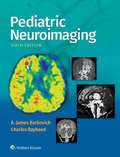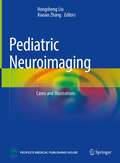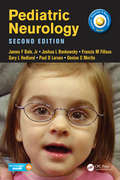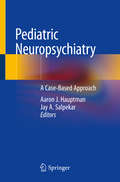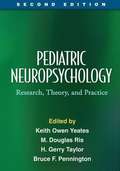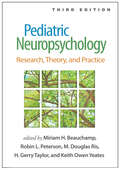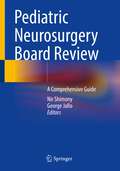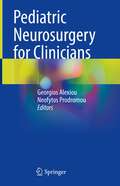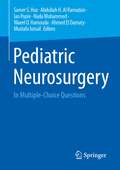- Table View
- List View
Pediatric Mental Health for Primary Care Providers: A Clinician's Guide
by Sarah Y. Vinson Ebony S. VinsonThe purpose of this book is to provide a children’s mental health resource tailored to the needs of physicians working with children. There are currently no such texts, despite the fact that there are patient care, healthcare systems, and workforce factors that indicate a strong need for such a resource. Approximately 1 in 5 children are diagnosed with a mental illness by the age of 18. Additionally, mental health conditions, including Attention Deficit Hyperactivity Disorder, are consistently among the most common chronic conditions in pediatric clinical populations. Delays in both diagnosis and treatment increase the morbidity associated with these conditions. These delays expose the child to negative ramifications of his/her illness and can impact rates of poor academic performance, substance use disorders and criminal justice system involvement – potentially impacting long-term life trajectories. Early identification of mental illness and appropriate intervention is critical to the healthy development of youth, though physicians in primary care and pediatrics are seldom trained to detect and treat such illnesses. The importance of recognizing mental illness is reflected in practice guidelines for pediatric primary care providers as well as in how service delivery is being structured, but this does not offer in-depth clinical guidelines. Additionally, integrated care and medical home models include mental health as key components, though yet again physicians are often not trained to work with these models. While clearly indicated clinically, these requirements do not come with significant increases in reimbursement and are added to an already demanding schedule. Increasingly, providers are also expected to use evidence based screening instruments without exposure to this body of literature. Some guidance on using those instruments in context will help them to use those tools more effectively. Finally, primary care providers and even some adult psychiatrists and psychologists are operating in a healthcare system with a severe, nationwide shortage of child and adolescent psychiatrists and mental healthcare providers. While a text certainly cannot single-handedly compensate for such a workforce shortage, it could potentially help to mitigate the negative impact on patients by facilitating early identification and treatment in the primary care setting. Additionally, with more effective treatment in pediatric settings, less complex cases may be addressed before specialty care is needed, and the expertise of child and adolescent psychiatrists can be more effectively used for more complex cases.Pediatric Psychiatry in Primary Care is the ultimate resource for clinicians working with children, including pediatricians, family physicians, general psychiatrists, psychologists, early career child psychiatrists, social workers, nurses, school counselors, and all clinical professionals who may encounter children struggling with psychiatric disorders.
Pediatric Metabolic Syndrome
by Sarah E. Messiah Steven E. Lipshultz Tracie L. MillerIn just under three decades, the world has witnessed an enormous rise in obesity with a parallel growth in cardiometabolic disease risk factors characterized by insulin resistance, dyslipidemia, and hypertension, together known as the metabolic syndrome - conditions previously unheard of in children and adolescents. During this time, we have little knowledge of the global and cumulative detrimental health effects of childhood obesity. As obese children age, not only will their health be negatively affected, but infertility and pregnancy complications associated with the metabolic syndrome will affect generations to come. The work force will undoubtedly be affected because of increased sick days and decreased work productivity. Identifying children and adolescents at the earliest stages of chronic disease onset should be the goal of clinical practice, yet there is no clear guidance for defining the risk of metabolic syndrome or appropriate risk-factor thresholds in these groups. If children are identified early in the disease process, lifestyle and clinical interventions can be instituted when they are potentially more effective. Pediatric Metabolic Syndrome: Comprehensive Clinical Review and Related Health Issues approaches the pediatric metabolic syndrome by elucidating its effects on specific organ systems and by considering the problem through understanding the social, psychological and economic consequences of it. The Editors have recruited an invited group of esteemed experts in the field to provide the most timely and informative approaches on how to deal with this health crisis. Through educating our practitioners, our future researchers, our health and community organizations, our legislators and our families and children, we have the best chance at improving the health trajectory of the next generation.
Pediatric Minimal Access Surgery
by Jacob C. Langer Craig T. AlbaneseThis authoritative guide reviews the evoloving evidence-based literature for a wide variety of procedures and techniques in pediatric minimal access surgery (MAS)-providing expertly-written chapters that cover the techniques specific to a broad range of diseases, as well as current advances in urology, neurosurgery, and spinal and cardiac surgery.
Pediatric Musculoskeletal Infections: Principles & Practice
by Martin J. Herman Mohan V. Belthur Ashish S. Ranade James A. FernandesPediatric musculoskeletal infections are common globally and represent about 1-2% of all pediatric hospital admissions in the developed world and about 10-20% of admissions in the developing countries. If untreated or treated inadequately, pediatric bone and joint infections can cause significant mortality and morbidity. The functional and economic burden to the family and community at large also presents a significant public health problem.This book serves as an evidence-based, comprehensive review of the current concepts for the early diagnosis and management of pediatric musculoskeletal infections. Currently, there are no comprehensive, easily accessible books on this topic. This first of its kind book also uses a multidisciplinary and global approach by including contributions from editors and authors worldwide. The long-term goal of this text is to help improve the quality of care provided to children with musculoskeletal infections improve patient safety, reduce the cost of care, and add value to the care provided to these children and thus reduce the economic burden.Broken up into five sections, the first part of this text covers the epidemiology, microbiology, pathological consequences, antibiotic therapies, systemic effects, and imaging modalities of pediatric musculoskeletal infections. Section two takes a detailed look at acute pediatric musculoskeletal infections. Infections discussed in this section include acute hematogenous osteomyelitis, septic arthritis, pyomyositis, complex musculoskeletal infections, musculoskeletal infections in the neonate and acute surgical site infection after pediatric orthopedic surgery. Section three focuses on chronic osteomyelitis and its sequelae. Section four examines anatomic region-specific considerations in musculoskeletal infections. The topics that are expanded upon are epiphyseal osteomyelitis, Pediatric hand and foot infections, tuberculosis of the axial and the appendicular skeleton, and non-tuberculous infections of the spine. Finally, the fifth section includes an overview of less common musculoskeletal conditions such as, fungal infections, brucellosis, hydatid disease, gas gangrene, viral musculoskeletal infection and meningococcal infections.Written by experts in the field, Pediatric Musculoskeletal Infections: Principles and Practice serves as an easily accessible resource for a global audience of healthcare providers from multiple disciplines to aid them in making informed decisions while managing pediatric bone and joint infections. Paediatricians, orthopedic surgeons, infectious disease physicians, radiologists, pathologists, family physicians and any other healthcare providers involved in the care of children with musculoskeletal infections will find immense value in this reference as will medical students, residents and fellows.
Pediatric Musculoskeletal Physical Diagnosis: A Video-Enhanced Guide
by Mininder Kocher Kenneth NoonanMusculoskeletal complaints represent a large percentage of cases seen by pediatricians, family physicians, and other first-line clinicians who work with children and adolescents. Pediatric Musculoskeletal Physical Diagnosis: A Video-Enhanced Guide helps health care practitioners arrive at an accurate diagnosis and determine the need for a referral. Written by leaders in pediatric orthopaedics, this practical guide is a comprehensive, multimedia resource covering the physical examination and the next steps to diagnosis of disorders of the growing musculoskeletal system. This is the tablet version which does not include access to the videos mentioned in the text.
Pediatric Musculoskeletal Ultrasonography
by Yasser El MiedanyThis book provides a comprehensive compilation of musculoskeletal ultrasonography (MSUS) fundamentals in pediatric rheumatology with emphasis on imaging techniques, normal anatomy, approaches towards standardization, and the spectrum of pathologic findings seen in the pediatric population. It examines the techniques and pitfalls of MSUS in pediatrics and compares sonoanatomy in pediatric patients versus adults. Chapters cover a range of anatomical sites, including shoulder and arm, elbow and forearm, wrists and hands, hip and thigh, knee and leg, and ankle and feet. The text also discusses the use of ultrasonography in juvenile inflammatory arthritic conditions and sports-related injuries. Finally, the book concludes with a summary of the recent advances in pediatric musculoskeletal ultrasonography. Featuring contributions from a large international group of leaders in the field, Pediatric Musculoskeletal Ultrasonography is an authoritative reference for pediatric and adult rheumatologists, sonographers, radiologists, physiotherapists, and orthopedic specialists.
Pediatric Nail Disorders (Pediatric Diagnosis and Management)
by Robert Baran, Smail Hadj-Rabia, Robert SilvermanThis is a highly illustrated guide to the diagnosis and management of nail conditions in children. With new material on genetics and on developments such as dermoscopy, it will be invaluable as a reliable clinical reference for both dermatologists and pediatricians, as well as those in family practice.
Pediatric Nasal and Sinus Disorders
by Tania Sih Peter A. R. ClementThe first and only source to offer a detailed and authoritative review of every aspect of nasal and sinus disorders in children, this reference provides an impressive collection of reviews on topics ranging from disease mechanisms and immunodefense to diagnosis, medical management, and surgical strategy.
Pediatric Neoplasia
by Alexander Craig Mackinnon JrPediatric Neoplasia: Advances in Molecular Pathology and Translational Medicine presents many of the major, relevant advances in molecular pathology that are occurring in the field of pediatric oncology and will serve as a useful overview for resident and attending physicians as well as scientists interested in understanding the molecular pathology of pediatric cancer in the context of clinical medicine. Chapters are based upon organ systems, and each is written by an expert or pair of experts in their field with subspecialty training and extensive clinical experience. Each chapter describes a variable number of tumors and includes an overview of the classification system and clinicopathological characteristics of each tumor. This is followed by a discussion of the molecular pathology relevant to a specific tumor, including specific molecular markers of the tumors, methods used for diagnosis or clinical management, clinical significance of the markers, and if appropriate, a description or discussion of current activities in translational research or issues that need to be addressed in the future. Pediatric Neoplasia: Advances in Molecular Pathology and Translational Medicine will be of great value to pathologists, oncologists, hematologists, internal medicine and pediatric specialists, as well as pharmaceutical professionals and translational and clinical researchers.
Pediatric Nephrology
by Norishige Yoshikawa Ellis D. Avner Patrick Niaudet William E. HarmonHere is an extensive update of Pediatric Nephrology, which has become the standard reference text in the field. It is global in perspective and reflects the international group of editors, who are well-recognized experts in pediatric nephrology. Within this text, the development of kidney structure and function is followed by detailed and comprehensive chapters on all childhood kidney diseases.
Pediatric Neuro-Ophthalmology
by Michael C. Brodsky"Due to the generous representation of the afferent visual system within the brain, neurological disease may disrupt vision as a presenting symptom or as a secondary effect of the disease. Conversely, early developmental disturbances of vision often disrupt ocular motor control systems, giving rise to complex disorders such as nystagmus, strabismus, and torticollis. The signs and symptoms of neurological disease are elusive by their very nature, presenting a confounding diagnostic challenge. Neurological medications and neurosurgical treatments can produce neuro-ophthalmological dysfunction that can be difficult to distinguish from disease progression. Affected patients may experience substantial delays in diagnosis, and are often subjected to extensive (and expensive) diagnostic testing. Scientific articles pertaining to specific disorders are scattered throughout medical subspecialty journals. These children continue to "fall through the cracks" of our medical education system. The increasing recognition that pediatric neuro-ophthalmology comprises a distinct set of diseases from those seen in adults has led to its emergence as a dedicated field of study. "Since the original publication of Pediatric Neuro-Ophthalmology nearly fourteen years ago, interest in the field has burgeoned. Pediatric ophthalmology and pediatric neurology subspecialty conferences often include symposia dedicated to recent advances in pediatric neuro-ophthalmology. Technical advances in neuroimaging have given rise to a more integrated mechanistic classification of neuro-ophthalmological disease in children. Our understanding of neurodevelopmental disorders of the visual system has expanded, longstanding monoliths have been dissembled into component parts, basic molecular mechanisms have taken center stage, and genetic underpinnings have become definitional. Evolutionary alterations can now be observed at the level of the gene, adding a new dimension to our understanding of disease pathogenesis. New classifications now encompass clinically disparate conditions. Descriptive definitions have been supplanted by mechanistic ones, and clinical definitions superseded by genetic ones. Our concept of disease pathogenesis has been revised and in some cases overturned. Bearing witness to these remarkable advancements has compelled me to enhance and expand the first edition of Pediatric Neuro-Ophthalmology into this new and revised one. "In the first edition of this book, our goal was to present the clinical characteristics, diagnostic evaluation, and therapeutic options for the common neuro-ophthalmologic disorders of childhood. In so doing, we designed the book to be provide a narrative journey through the thought processes involved in the clinical management of these disorders. In this edition, I have retained the basic narrative format of original book, while expanding the exploration of these complex visual disorders in the context of the many new scientific advancements and discoveries that have come to light. These conditions are fun to diagnose, fascinating to understand, and gratifying to manage." --from the Preface to the 2nd Edition.
Pediatric Neuro-oncology
by Katrin Scheinemann Eric Bouffet"The editors. . . have done an outstanding job of presenting. . . complex information in a lucid manner - this book is a must-read for the global community of aspiring students and neuro-oncology practitioners. " Amar Gajjar, MD in the Foreword This is a succinct introduction to pediatric neuro-oncology. It summarizes the key advances in molecular biology that have helped transform this rapidly evolving field and provides up-to-date coverage of major and emerging treatment modalities as well as supportive care. Separate chapters present each kind of pediatric brain cancer and its diagnosis and treatment. As more children survive brain cancer, the importance of quality of life issues and helping survivors to cope with the neuropsychological impact and long-term effects of current therapies has come into sharper focus; these topics are also addressed in the book, as are palliative care and pediatric neuro-oncology in countries with limited resources. The book is aimed at trainees and practitioners who seek an up-to-date text in pediatric neuro-oncology that is both comprehensive and concise.
Pediatric Neuro-oncology
by Katrin Scheinemann Eric BouffetWhile the first edition of this book provided a succinct introduction to pediatric neuro-oncology, biological knowledge of childhood CNS tumors has “exploded” over the past few years and a new edition of this textbook is needed to keep it up-to-date. This updated edition will include chapters on cancer predisposition in children with brain tumors, gliomas, embryonal brain tumors, ependymoma, CNS-GCT, targeted therapies in pediatric brain tumors, and long-term sequelae. New developments covered include the following: - Techniques like DNA methylation have improved the diagnostic process, and have led to an integrated diagnosis of histology, ICH and methylation. - Tumor pathways have been detected, which defines more subgroups within a tumor entity, and results in more individualized treatment for the patient. - Therapeutic options outside the standard combination of surgery, chemotherapy, and radiation have either been implemented within the last years, or are currently under consideration. This book will be aimed at pediatric oncologists and neurooncologists, neurosurgeons, radiation oncologists. Chapters detailing quality of life and supportive care will make this 2nd edition a useful resource for nurses, social workers, physiotherapists, and occupational therapists alike.
Pediatric Neurogastroenterology
by Nikhil Thapar Christophe Faure Carlo Di LorenzoNeurogastroenterology is devoted to "study the interface of all aspects of the digestive system with the different branches of the nervous system". Over the past 15 years advances in this field has greatly improved our understanding in primary functional and motility disorders in children. Neurogastroenterology has also begun to revolutionize our vision of "organic" diseases like inflammatory bowel disease, obesity, diabetes as well as microbial-host interactions. Major advances have also been achieved during these years in the knowledge of mechanisms of development of the enteric nervous system at the molecular level allowing a better understanding of diseases related to developmental anomalies and opening perspectives to new treatments with stem cells. Pediatric Neurogastroenterology: Gastrointestinal Motility and Functional Disorders in Children is dedicated to report the most accurate and recent knowledge in the field. Written by the world-renown experts, the book covers the field by providing a comprehensive and up-to-date review and practical guide to pediatric gastrointestinal motility and functional disorders for pediatricians, pediatric gastroenterologists, adult gastroenterologists and all professionals involved in the treatment of children with such disorders.
Pediatric Neurogastroenterology
by Nikhil Thapar Christophe Faure Carlo Di LorenzoThis volume provide a comprehensive and up-to-date theoretical review and practical guide on pediatric gastrointestinal motility and functional disorders. The latest edition includes extensively revised and new chapters to reflect the rapidly growing field of pediatric neurogastroenterology. New topics covered include neurobiology of pain in children, functional oropharyngoesophageal assessment, dysautonomia, and psychotropic drugs. The text also features instructive illustrations, photographs, and tables. Written by world-renown experts in the field, Pediatric Neurogastroenterology: Gastrointestinal Motility and Functional Disorders in Children, Second Edition is a valuable resource for pediatric gastroenterologists, adult gastroenterologists, pediatricians, and all professionals involved in the treatment and management of children with such disorders.
Pediatric Neurogastroenterology: Gastrointestinal Motility Disorders and Disorders of Gut Brain Interaction in Children
by Nikhil Thapar Christophe Faure Carlo Di LorenzoThis third edition brings together the latest in research and clinical practice of the expanding field of pediatric neurogastroenterology. In addition to a comprehensive review of the current state of the art, many chapters have been significant revised and updated, covering the latest discoveries of the delicate and detailed mechanisms of the neuroenteric system as well as relationships of the latter with microbiota and metabolites produced by resident intestinal bacteria. The book also covers rapidly-changing techniques to assess clinical problems, along with international diagnostic criteria and recommendations and guidelines for clinical management. The content is supported by ample figures, photographs and selected video segments.Remaining the gold standard text in this up-and-coming field, Pediatric Neurogastroenterology 3e is dedicated to reporting the most accurate and recent knowledge available. Written by international experts in the field, the book is a comprehensive and up-to-date theoretical review and practical guide to pediatric gastrointestinal motility and functional disorders to pediatricians, pediatric gastroenterologists and all professionals involved in the treatment of children with such disorders.
Pediatric Neuroimaging
by A. James Barkovich Charles RaybaudThis newest addition of the comprehensive Pediatric Neuroimaging combines thousands of images with detailed textual descriptions to help you diagnose a wide range of brain, spinal, and head and neck disorders in the pediatric patient. The authors have chosen a clear, concise writing style that encourages you to grasp information quickly. By dealing with a broad range of disorders, from everyday problems to less common ones, and explaining how to recognize and differentiate them, this book offers you the opportunity to provide a concise differential diagnosis on most patients you are likely to encounter in your practice.
Pediatric Neuroimaging: Cases and Illustrations
by Hongsheng Liu Xiaoan ZhangThis book aims to provide readers practical information on clinical diagnosis of pediatric neurological diseases. Topic areas include congenital malformations of the brain and cerebral vessels, brain tumors, intracranial infections, vascular diseases, metabolic encephalopathy, brain damage and destructive diseases. Utilizing a case-based format, the procedure of streamline disease recognition is presented in a clear and concise manner. Each case is supported by representative images, a discussion of the disease, and a description of the most characteristic imaging features of the disorder. Written by radiologists who have been involved pediatric imaging diagnosis for a long time, this case-based book will be a valuable reference for radiologists, paediatricians and neurologists, as well as those who are interested in related field.
Pediatric Neurology: A Color Handbook (Pediatric Diagnosis and Management)
by James Bale Joshua Bonkowsky Francis Filloux Gary Hedlund Paul Larsen Denise MoritaThe fundamental goal of the revised edition of this acclaimed text is to provide comprehensive, practical, and straightforward information about the developing nervous system that is as relevant to those embarking on careers in pediatric neurology as it will be to the experienced practitioner who cares for infants, children, and adolescents. New to this edition are chapters on tumors of the nervous system, autism and related conditions, and practice parameters in child neurology.
Pediatric Neuropsychiatry: A Case-Based Approach
by Aaron J. Hauptman Jay A. SalpekarAdult neuropsychiatry is now a well-established field with numerous reputable references. Practitioners who work with children routinely note how references and practitioners knowledgeable in the equivalent work in the pediatric world are rare. Child psychiatrists and neurologists frequently work with individuals struggling with these conditions and would strongly benefit from such a reference that incorporates medical work-up, psychopharmacological recommendations, family/support recommendations and theoretical pathophysiology. Pediatricians and developmental pediatricians often treat children with behavioral and neuropsychiatric sequelae, but are not well-trained in the neuropsychiatric management of these cases. Neuropsychologists and educational psychologists working with children and adults with pediatric-onset conditions will also find the text helpful to contextualize their cases, better-understand the medical evaluation and management and perhaps adjust recommendations that would supplement their own testing methods. Finally, sub-specialists in adult neurology, psychiatry and neuropsychiatry often find themselves working with these children by default as there are few pediatric subspecialists who are available to accept them into practice. When facing complex neuropsychiatric illness in children, many clinicians are stymied because they may have “never seen a case like that”. This text fills the wide gap that currently exists and helps move this field forward. The approach utilized in adult neuropsychiatry that is both clear and accessible does not yet have an equivalent in the pediatric realm, but there is tremendous interest in its development. Children and adolescents with neuropsychiatric conditions are very common and they and their caregivers often struggle to find professionals well educated in this field. Ultimately, a wide range of clinicians will find this text to be a very helpful resource for diagnosis and management in the spectrum of pediatric neuropsychiatric conditions. The case-based approach is also unique with respect to neuropsychiatric approaches, and the clear cut, reader-friendly approach of such a format would likely be well-received among physicians looking for a resource on this issue.
Pediatric Neuropsychology, Second Edition
by Keith Yeates M. RisThe most comprehensive, authoritative reference of its kind, this acclaimed work examines a wide range of acquired, congenital, and developmental brain disorders and their impact on children\u2019s neuropsychological functioning. Leading experts present state-of-the-art knowledge about how each condition affects the developing brain; the nature and severity of associated cognitive, behavioral, and psychosocial impairments; and effective approaches to clinical evaluation and treatment planning. New to This Edition Reflects significant scientific advances. An additional coeditor, Bruce F. Pennington. Chapters on math, reading, and language disabilities; attention-deficit/hyperactivity disorder; autism; and intellectual disabilities. Medical disorders not covered in prior edition acute disseminated encephalomyelitis and multiple sclerosis; tuberous sclerosis; childhood stroke; and fetal alcohol syndrome. A chapter on evidence-based neuropsychological interventions.
Pediatric Neuropsychology, Third Edition: Research, Theory, and Practice
by Miriam H. Beauchamp, Robin L. Peterson, M. Douglas Ris, H. Gerry Taylor and Keith Owen YeatesRecognized as the definitive reference and text on the relationship between brain health and behavior in children and adolescents, this volume is now in a third edition with 75% new material, including major updates throughout and numerous new chapters. Leading experts provide a neuropsychological perspective on medical, neurological, genetic, and developmental disorders that are frequently seen in clinical practice. The volume examines the impact of each condition on the developing brain; explores associated cognitive, behavioral, and psychosocial impairments; and shows how the science translates into achieving better outcomes for children. New to This Edition *Reflects 12 years of significant research advances and the expanding role of pediatric neuropsychologists; increased attention to evidence-based intervention throughout. *Chapters on additional medical and neurodevelopmental conditions: pediatric stroke, congenital heart disease, type 1 diabetes, and movement disorders. *Section on genetic disorders: fragile X, Williams syndrome, 22q11.2 deletion syndrome, and Down syndrome. *Section on emergent and controversial conditions: nonverbal learning disabilities, dysexecutive syndrome, pediatric acute-onset neuropsychiatric syndrome, and sluggish cognitive tempo.
Pediatric Neurosurgery Board Review: A Comprehensive Guide
by George Jallo Nir ShimonyThis specialized textbook will be dedicated to the various disease topics of pediatric neurosurgery and management strategies. The text will cover the different aspects of the field of pediatric neurosurgery in a unique way by giving state of the art up-to-date synopsis with references to recent publications. More specifically, the whole book is dedicated to a comprehensive discussion of brainstem tumors and other lesions. It will be composed of 20 chapters. The various chapters will start from updates regarding the development of the nervous system and the clinical differences in assessing the infant or a child in comparison to the adult patient. The book then will focus on various pathologies starting with hydrocephalus, pediatric brain and spine tumors, congenital malformation, spasticity, epilepsy, and more. The proposed textbook will be enriched with diagnostic and surgical images, and illustrations that cover all types of pediatric neurosurgery pathologies, with an emphasis on evidence-based data that reflects the controversies and possible solutions. The main structure of each chapter will include a short synopsis of the topic at hand, questions and answers that will inspire the reader for better understanding, learning objectives, and key references for further reading. Written by experts in the field, Pediatric Neurosurgery Board Review serves as a valuable resource for neurosurgery residents and fellows studying for their neurosurgery exams, as well as an educational material for neurosurgery specialists after graduation by discussing pediatric neurosurgery in more convenient way to review and understand key information in this field.
Pediatric Neurosurgery for Clinicians
by Georgios Alexiou Neofytos ProdromouThis book presents a detailed overview of a spectrum of pediatric neurosurgical conditions. It features detailed insight into the techniques available for examining abnormalities, hemorrhages and a variety of tumors. Relevant surgical methodologies are described in relation to a clinical problem or disorder, ensuring that the reader can systematically develop their knowledge of how to perform both routine and more-obscure procedures presently utilized to treat these conditions. Pediatric Neurosurgery for Clinicians is a comprehensive guide detailing methodologies for applying a range of surgical techniques based upon a range of clinical questions. Therefore, it is a critical resource for all practicing and trainee physicians who encounter children with disorders affecting their neurological systems in disciplines within neurosurgery, neurology, radiology, oncology and pathology.
Pediatric Neurosurgery: In Multiple-Choice Questions
by Samer S. Hoz Mustafa Ismail Abdullah H. Al Ramadan Ian Pople Nada Mohammed Waeel O. Hamouda Ahmed El DamatyThis book is the first review book to use the multiple-choice question format in pediatric neurosurgery. More than 500 MCQs are provided in a convenient format that is suitable for self-study.The mission of the book is to help readers understand the content and maintain the knowledge, rather than merely finding answers for complicated questions. The strategy and the format of the questions provide a step-by-step, thorough explanation of each disease from the definition, associated anatomy, pathology, clinical features, radiology to surgical decision-making, and surgical tricks, providing a comprehensive and concise overview. Answers and definitions appear immediately below the questions to facilitate information retention. It is an important asset for residents across neurosurgical disciplines as it includes much of the pediatric neurosurgery knowledge that neurosurgical residents need to prepare for their certification tests. It is also useful for those seeking ways to solidify their knowledge or maintain their current certification. This book is an adjunct to the existing texts and does not intend to be the primary source of information; it rather aims to help readers identify their relevant strengths and weaknesses in the area.
